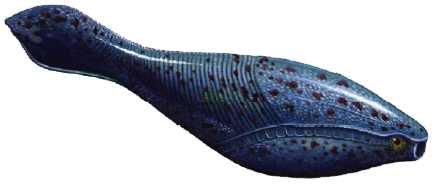Dinosaur Home » A-Z Dinosaurs List »Arandaspis |
| Arandaspis |
The name of Arandaspis(In Greek aspis means "shield") was given to the best preserved specimens. This was coined to celebrate the aboriginal Aranda tribe of the area and to reflect the fish's bony head covering. |
In 1959 fossils of 4 distinct types of fish were discovered south of Alice Springs, in the heart of the Australian continent.They were entombed in marine sandstones, laid down in a shallow sea about 500 million years ago.It was not until the late 1960's that these remains were recognized as belonging to the earliest known vetebrates. |
|
Arandaspis had a streamlined, deep-bodied shape.With no fins to stabilize it, it would have swum in an erratic,tadpolelike style.Its lower body was covered in oblique rows of small bony scales, each shaped like a cowrie shell and decorated with pointed tubercles, which must have given the skin a rough,abrasive texture, like that of a shark.
 |
|
The front of the body was encased in a head shield, made from two large plates of thin bone -- a deep rounded ventral(underside) plate and a flatter dorsal(topside) plate.There were openings for the eyes, nostrils and the single pair of gill apertures on either side.
|
Deep groves in the shield marked the position of the lateral line canals -- the organs in a fish that sense vibrations. Arandaspis jawless mouth was on the underside of its head, suggesting that it may have fed on or near the seabed.
|
|
|
|
Like other heterostracans, there were small movable plates inside its mouth equipped with ridges of dentine.these could have formed a flexible pair of "lips"
capable of scooping or sucking up particles of food from the mud.
|
|
Arandaspis facts:
|
| Name |
Arandaspis |
| Time |
Early Ordovician |
| Locality |
Australia (Northern Territory) |
| Size |
Possibly 6in/15cm long |
|